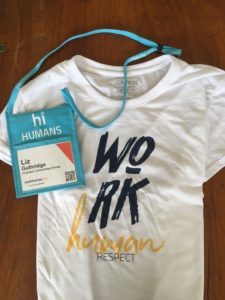 One size doesn’t fit all for clothes, bicycles, prescription drugs – and certainly not humans at work.
One size doesn’t fit all for clothes, bicycles, prescription drugs – and certainly not humans at work.
That message came through loud and clear from many presenters, forums and discussions at the 2017 WorkHuman conference.
The more than 1,600 of us who attended the conference in Phoenix are all unique human beings with our own one-of-a-kind brain.
And it’s time that we, employers and those of who support organizations own up to our individuality and embrace it, as one of the keynoters, former First Lady of the United States Michelle Obama, advised.
We also need to introduce even more individualization into the workplace.
Why? If we want to optimize human potential in the cognitive age in which we live and work, we need to create work cultures that celebrate individualization.
From the individual perspective, the more comfortable you feel in bringing your whole, authentic self to work each day without hiding behind a façade, the more positive energy you have to devote to work and colleagues. When you feel appreciated for who you are and what you do, you can build stronger social connections with colleagues. You’re also more open to growing and developing.
From the employer perspective, organizations that provide customized and nuanced work environments are benefiting from better performance, greater engagement, and higher retention, according to individuals from IBM Watson Talent who spoke on “The employee experience in the cognitive era.”
What does individualization look like these days? Organizations are taking such actions as:
- Helping managers and leaders spend more talking with employees about their performance and other issues, rather than spending time in conference rooms talking about them. For example, Rahul Varma, Global Head of Talent & Learning, Accenture, said that before they got rid of performance ratings, leaders were spending 75% of the time they devoted to performance management talking about people and putting them in buckets, which left little time for meaningful leader and employee conversations about performance and development. (By the way, increasing quality conversation time is big benefit of doing away with performance ratings. Even better, conversations become more future focused.)
- Focusing on ensuring individuals have a meaningful experience at work. When leaders start thinking about work experiences rather than just engagement, they introduce more design thinking and actions into their processes. This has the benefit of involving employees more in taking an active role in their work environment. IBM Watson Talent is now measuring employee experience through a special index of five dimensions. These include belonging, purpose, achievement, happiness and vigor. The latter covers energy, enthusiasm and excitement.
- Giving employees permission to control the amount of stimulation coming at them in the work environment. In other words, individuals who need quiet time to concentrate can find quiet, secluded work spaces that help them focus, either at the office or at home.
- Recognizing individuals for their efforts as well as their contributions in ways that resonate with them. As the CEO and co-founder of Globoforce, Eric Mosley explained, companies that spend just 1% of their total compensation on recognition are “putting rocket fuel into their company performance.” And he shared statistics to prove his point. Recognition is eight times more powerful than salary increases when it comes to improving employee engagement. Also, 83% of employees who receive recognition from either leaders or peers report a positive employee experience against 38% who don’t.
- Celebrating diversity, inclusion and belonging at work. This means acknowledging that people come in all different shapes, sizes, stripes and personality styles, as the best-selling author of Quiet: The Power of Introverts in a World That Can’t Stop Talking, Susan Cain, described. For example, everyone needs to recognize that people bring all kinds of stuff with them when they come to work, that people want to do work that matters, and that they appreciate kindness.
While individualization is important, it was just one of the six HR megatrends the WorkHuman conference featured. The other five are continuous conversations and feedback, crowdsourced rewards and pay, team engagement, the new role of coach and HR as facilitator of culture.
Yet from my perspective, most, if not all, of these other megatrends support making more individualization in the workplace possible.
Individualization has existed, just not to the extent it’s taking root now. For example, in the late 1970s, progressive employers, such as American Can, started offering cafeteria-style benefits, also referred to as flexible benefits.
Back then the appeal was to allow employees to decide how to best allocate their benefit budget from their company, based on the stage of their career.
To show how times have changed, the video that introduced flexible benefits to American Can employees was 18 minutes long and called “Five Different Arthur C. Canbys” – from the white single guy, the married man, the family man, the father of the bride, and the retiree.
The infant who played the role of Arthur’s baby daughter in the video is now all grown up, the mother of young two girls herself. (She’s also my stepdaughter. I met and married her dad long after she played her one and only nude scene, which involved being bathed in a bathtub.)
Now American Can no longer exists. (It morphed into Citigroup.) Arthur Canby’s head would be spinning from all the other changes. Technology is more accessible and sophisticated. Companies are more global. The speed of work is faster. The workforce is more diverse and mobile. And attention spans are shorter.
Thanks to all of these trends, we crave more humanity at work, especially being treated as individuals.
What are you doing to make work feel more human?

0 Comments